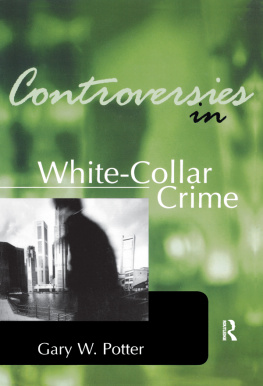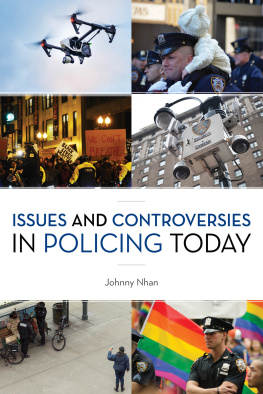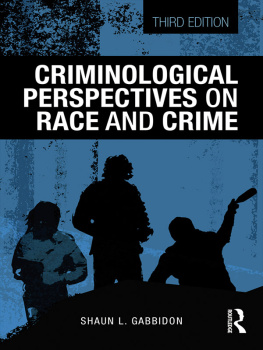Criminological Controversies
Foundations of Social Inquiry
Scott McNall and Charles Tilly
Series Editors
Criminological Controversies: A Methodological Primer
John Hagan, A. R. Gillis, and David Brownfield
Immigration in America's Future
David M. Heer
What Does Your Wife Do? Gender and the Transformation of Family Life
Leonard Beeghley
FORTHCOMING IN 1996
Social Change
Thomas D. Hall, Darrell La Lone, and Stephen K. Sanderson
Sexual Politics
Sheila Tobias
Contact Westview Press for information about additional upcoming titles.
Foundations of Social Inquiry
First published 1996 by West view Press
Published 2018 by Routledge
711 Third Avenue, New York, NY 10017, USA
2 Park Square, Milton Park, Abingdon, Oxon OX14 4RN
Routledge is an imprint of the Taylor & Francis Group, an informa business
Copyright 1996 Taylor & Francis
All rights reserved. No part of this book may be reprinted or reproduced or utilised in any form or by any electronic, mechanical, or other means, now known or hereafter invented, including photocopying and recording, or in any information storage or retrieval system, without permission in writing from the publishers.
Notice:
Product or corporate names may be trademarks or registered trademarks, and are used only for identification and explanation without intent to infringe.
Hagan, John, 1946
Criminological controversies : a methodical primer / John Hagan, A. R. Gillis, David
Brownfield.
p. cm (Foundations of Social Inquiry)
Includes bibliographical references and index.
ISBN 0-8133-1083-0 (alk. paper). ISBN 0-8133-1084-9 (pbk.)
1. Criminology. 2. CrimeSociological aspects. I. Gillis, A. R. II. Brownfield,
David. III. Title. IV. Series: Foundations of Social Inquiry
HV6025.H269 1994
364dc20
96-1110
CIP
ISBN 13: 978-0-8133-1084-8 (pbk)
When the dung beetle moves, Hosteen Nashibitti had told him, know that something has moved it. And know that its movement affects the flight of the sparrow, and that the raven deflects the eagle from the sky, and that the eagles stiff wing bends the will of the Wind People, and know that all of this affects you and me, and the flea on the prairie dog and the leaf on the cottonwood. That had always been the point of the lesson. Interdependency of nature. Every cause has its effect. Every action its reaction. A reason for everything. In all things a pattern, and in this pattern, the beauty of harmony. Thus one learned to live with evil, by understanding it, by reading its cause. And thus one learned, gradually and methodically, if one was lucky, to always go in beauty, to always look for the pattern, and to find it.
Tony Hillerman, Dance Hall of the Dead
It is easy to feel besieged by crime, if only because we hear so much about it. It is an interesting exercise to simply observe how much news about crime we see on television, hear on the radio, and read in newspapers and magazines. Of course, reports about street crime are prominent. Local news stories feature reports of drug busts, assaults and murders, arson, as well as burglaries and robberies. Meanwhile, new kinds of street crime also proliferate and captivate national attention. Car jackings, drive-by shootings, stalkings, and home invasions compete with more familiar types of crime. In addition, crime penetrates areas of life that we would like to believe are immune to it. Insider trading infests our stock markets, health-care fraud infects our hospitals, violence intrudes into our schools, illegal recruiting invades our amateur sports, sexual abuse infiltrates religious institutions, and corruption may be an integral part of our politics. So much around us seems so full of criminal implications.
The impact of crime on society has caused controversy, and criminology is increasingly a part of the public debate. Since science at large often has proven so useful in solving serious problems, it seems reasonable to expect that a science of crime should better inform us about, if not solve, our crime problems. Criminology, the scientific study of crime, often seeks to do so, although the progress is painfully slow. Developing insights takes time, especially when empirical accuracy is a necessity. The first steps of this infant science have largely involved adding rigor and perspective to our understanding of crime. For example, we have begun by simply gaining some sense of what crime is and how much there is of it. Even these very basic questions bring controversy.
Thus, it has taken criminologists a considerable amount of time to establish the point that there is much more to crime than the acts of force and predation that occur on our streets. The famous criminologist Edwin Sutherland (1949) devoted much of his career to convincing his peers and the public that many of the sharp and unethical practices of businessmen were indeed criminal. Sutherland coined the term white-collar crime and helped to make it a part of our everyday vocabulary. To do so, Sutherland sought to convince his peers and the public that many of our large corporations and their executives participated in activities that caused great social injury, that made these corporations or executives liable to legal punishment, and that these persons and organizations could, therefore, be thought of as criminal. That we now take this once controversial assertion for granted is a major accomplishment of an emerging science of crime. Todays controversies of white-collar crime are more likely to involve questions of how wide and how deep are the involvements of multinational corporations in corporate and white-collar crime.
Yet white-collar crime is only one kind of hidden crime that criminologists have made the subject of controversy and public concern. From the outset, those who would make a science of crime their goal have noted that our official counts of crime are only the tip of a figurative iceberg that constitutes the larger and unknown universe of crime. After first helping to insist that police and courts unify and routinize their official counts into Uniform Crime Reports, criminologists encouraged governments to invest resources in conducting surveys of victims of crime (Biderman, 1967). Called victimization surveys, these studies sought out first-hand citizen accounts of how often, in what ways, and by whom the public had been victimized. The results revealed a large number of crimes that were unreported and unrecorded in official crime statistics. For example, these studies demonstrated that much spousal and nonspousal abuse, assault and rape went unreported and unrecorded. These enumerations, although sometimes disputed, are now more often conceded and are increasingly a basis for reassessing the effects of crime deterrence and prevention efforts. The controversies today are more likely to focus on how far victim surveys can be taken in exposing problems like date rape among high school and college students, or childhood physical and sexual abuse by siblings and parents.
As we gain a better idea of how much crime there is we are in a better position to gauge how well-informed the public is in its perception of crime problems. Crime research directed at this issue increasingly indicates that the public overestimates how much violent crime there is, especially in proportion to property and public order crime involving alcohol and drugs. Although Americas crime problems are violent and often disproportionate to those of other Western nations, the public characteristically overestimates in absolute and relative terms how high their personal risks of violent victimization are (Warr, 1991). Furthermore, some parts of the public that think of themselves as most at risk, especially the elderly, are often less at risk than others. The media often intensifies such fears. Telling those who are most fearful that they are less at risk than they believe is a thankless and, therefore, potentially controversial task. Yet, taking on this task may be an important part of dissuading Americans from abandoning their streets and cities and arming themselves for self-protection in ways that are more dangerous than effective. Helping the public to reassess their impressions of criminal risk, both in amount and in kind, may also be an important part of tempering the public appetite for severe forms of punishment, including the use of imprisonment and the death penalty.







